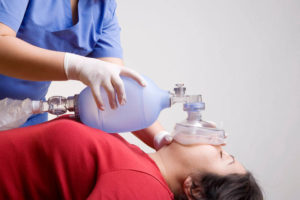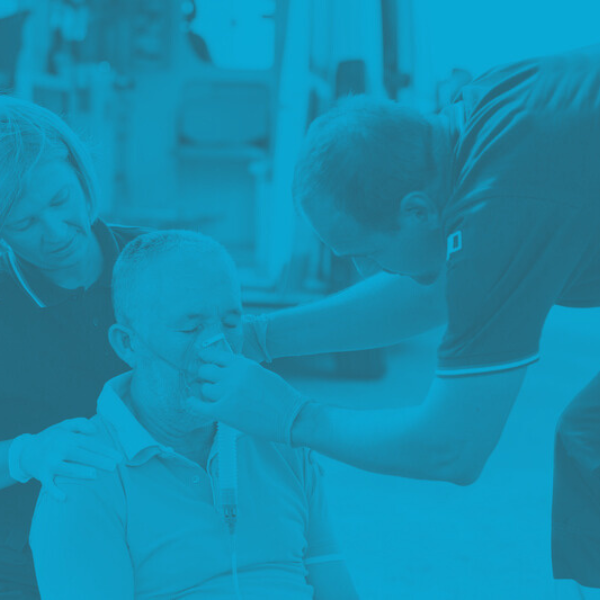Recognizing and Treating Respiratory Arrest
Recognizing and Treating Respiratory Arrest

by Greta Kviklyte
Life Saver, AMC
Co-authored by Kim Murray, RN, M.S.
posted on Apr 7, 2021, at 12:12 am
Respiratory arrest is a medical emergency that requires immediate intervention to prevent grave consequences. This condition affects patients of all ages for a variety of different reasons. According to a study published by the Society of Critical Care, the incidence of respiratory arrest in the United States has been increasing substantially in recent years, with an increase of 197 percent from 2002 to 2017.
Because of the severity of respiratory arrest, as well as its widespread nature, it is important to understand how to recognize and treat this condition properly. Below is an overview of respiratory arrest, its causes, how to recognize it and how to provide the most effective treatment.
We offer Online ACLS Certification and Renewal
What Is Respiratory Arrest?
Respiratory arrest occurs when someone stops breathing. The cessation of respiration quickly leads to other problems, including a loss of cardiac function and organ damage. Respiratory arrest often occurs following respiratory distress, a condition in which someone is having trouble breathing normally. Some of the signs of respiratory distress may include:
- Retractions, nasal flaring and other signs of increased respiratory effort
- Changes in consciousness levels
- Pale, cold skin
- Blue fingernails and lips from lack of oxygen
- Abnormal airway sounds
- Tachycardia
Respiratory distress should always be addressed in order to lower the chances of progression to respiratory arrest. Once respiratory distress has progressed to respiratory arrest, there will be no breath sounds or signs of breathing. Respiratory arrest is a medical emergency that must be treated immediately. If left untreated, respiratory arrest is universally fatal.
Respiratory Arrest vs Cardiac Arrest
 Respiratory arrest and cardiac arrest are two different conditions. While respiratory arrest indicates a cessation of breathing, cardiac arrest indicates a lack of heart function. However, even though these conditions are different, one will cause the other to occur if it isn’t treated promptly. In many cases, healthcare professionals or other rescuers find themselves treating both respiratory arrest and cardiac arrest at the same time, regardless of which condition was present first.
Respiratory arrest and cardiac arrest are two different conditions. While respiratory arrest indicates a cessation of breathing, cardiac arrest indicates a lack of heart function. However, even though these conditions are different, one will cause the other to occur if it isn’t treated promptly. In many cases, healthcare professionals or other rescuers find themselves treating both respiratory arrest and cardiac arrest at the same time, regardless of which condition was present first.
Respiratory arrest can have different causes. Some of these causes include:
Respiratory Muscle Weakness
Both fatigue of respiratory muscles and neuromuscular disorders can cause patients to experience respiratory muscle weakness. In some cases, this will lead to respiratory arrest. For example, if a patient has a disease that impacts the muscles, such as myasthenia gravis, respiratory muscle weakness is often a complication.
Decreased Effort
In some cases, the patient may be making less than the required respiratory effort, which leads to oxygen deprivation and the potential for respiratory failure. This condition is most often caused by central nervous system impairment. Any drug or disorder that impacts the functioning of the central nervous system could be to blame.
Airway Obstruction
Yet another possible cause of respiratory distress and/or arrest is obstruction of the airway. Infants under the age of three months, as well as patients who have loss of muscle tone and decreased consciousness, may experience upper airway obstruction. Foreign bodies, vomit, mucus, tumors and spasms can also obstruct the upper airway.
Lower airway obstruction can occur in patients of any age, usually as a result of drowning, bronchospasm, aspiration, infection, swelling or bleeding.
While some of these signs appear early in the progression to respiratory arrest, others appear later. For example, most patients will initially experience rapid breathing and a rapid heart rate while struggling to get enough oxygen. As the condition progresses, however, a slow heart rate and slowed respiration rate will develop.
How to Recognize Respiratory Arrest
 Regardless of the condition causing respiratory arrest, prompt treatment is essential. As little as five minutes without oxygen can result in severe organ damage, especially in the brain. For this reason, it is important to be able to recognize respiratory arrest quickly and even anticipate the development of respiratory arrest in patients showing signs of respiratory distress.
Regardless of the condition causing respiratory arrest, prompt treatment is essential. As little as five minutes without oxygen can result in severe organ damage, especially in the brain. For this reason, it is important to be able to recognize respiratory arrest quickly and even anticipate the development of respiratory arrest in patients showing signs of respiratory distress.
Healthcare providers and emergency medical personnel should anticipate a strong probability of respiratory failure and arrest in cases where patients show:
- Increased or decreased respiratory effort
- Very rapid breathing
- Very slow breathing
- Tachycardia or bradycardia
- Diminished distal air movement
- Bluish tint to the skin
- Coma
Treating Respiratory Arrest with Basic Life Support
As soon as you have recognized the presence of respiratory arrest, treatment should begin immediately. To properly manage this condition and give the patient the best chance of recovery, it is important to follow the appropriate treatment protocol. The exact treatment protocol that should be followed depends on the specifics of the patient’s condition.
The basic steps of treating patients with respiratory arrest are outlined below.
Step One: Check Responsiveness.
When respiratory arrest is suspected, the first step in the treatment process involves checking for a response from the patient. You can check for responsiveness by shaking the patient and asking “are you okay?” If the patient does not respond and breathing sounds are absent for ten seconds, move on to the next step.
Step Two: Call EMS and Obtain AED.
After you have determined that the patient is not breathing, the next step is calling emergency medical services. At the same time, it is also important to seek out an automated external defibrillator. If you are alone, you will need to complete both of these tasks yourself. However, if someone else is present, they can be assigned to either call for help or obtain the AED.
Step Three: Defibrillation.
Check to see if the patient has a pulse. If the patient has no pulse, use the AED to check for a shockable rhythm. If a shockable rhythm is present, use the AED to deliver shocks. Perform CPR between shock delivery.
At this point, the next step will depend on whether the patient has a pulse or continues with no pulse.
Step Four (With Pulse)
If the patient has a pulse, commence rescue breathing. Give one breath every five to six seconds for a total of 10 to 12 breaths per minute. Check for a pulse every two minutes.
Step Four (Without Pulse)
If the patient has no pulse, begin CPR. Perform 30 chest compressions for every two breaths. Each chest compression should be performed to a depth of 2 to 2.4 inches. Maintain a rate of chest compressions of approximately 100 to 120 per minute.
Treating Respiratory Arrest: Advanced Cardiac Life Support
When treating an unconscious patient in respiratory arrest, you will have multiple concerns that need to be addressed at the same time. One such concern is the patient’s airway. The airway must be opened in order to ensure that air can flow freely to the lungs. The first step in this process usually involves verifying that the airway is open and using a bag-valve-mask device to ventilate. Next, you will consider an advanced airway.
Opening the Airway
In most cases, it will be possible to open the patient’s airway by tilting the head and lifting the chin. However, if a neck or spinal cord injury is suspected, the rescuer should use the jaw thrust maneuver to open the airway instead.
Bag-Mask Ventilation
An oral or nasal pharyngeal airway can be used to institute bag-mask ventilation. However, an oral airway can be used only if the patient is unconscious, as gagging will occur in a semi-conscious patient. Keep in mind that patients can be bag-mask ventilated without an airway, but it may be extremely difficult in some cases.
When using bag-mask ventilation, be careful not to over-ventilate, as this can lead to serious complications. The goals of bag-mask ventilation are at least 94 percent oxygen saturation (100 percent if possible), with ventilations delivered once every five to six seconds. Overly aggressive ventilation can also be problematic. Ventilation is considered adequate as long as the patient’s chest is rising and falling with each respiration.
Placing an Advanced Airway
If the patient’s condition is deteriorating and/or mask-ventilations are not sufficient, an advanced airway should be placed. Multiple methods can be used to place an advanced airway, including the endotracheal tube, esophageal-tracheal tube, laryngeal tube and laryngeal mask airway.
Dangers of Over-Ventilation
When managing a patient in respiratory arrest, it is natural to want to act as aggressively as possible in hopes of preventing brain damage and other complications. However, overly aggressive treatment of respiratory arrest can actually be detrimental to the patient. One of the greatest risks is over-ventilation, which occurs when the healthcare provider or other rescuer gives too many breaths per minute or breaths that are larger than necessary. This can cause a variety of complications, including:
- Increased intrathoracic pressure
- Lower cardiac output
- Decreased venous return to the heart
- Vomiting
Be sure to follow the recommended ventilation protocols and algorithms carefully, taking care not to over-ventilate the patient.
Respiratory Arrest Management Training
Providing prompt, effective treatment to a patient in respiratory arrest is the best way to give the patient the highest chance of survival. However, the algorithms and protocols that must be followed when treating a patient in respiratory arrest can be complicated. In addition, when you are in a high-stress situation, it can be even more difficult to remember and administer the appropriate treatment properly. To ensure that you have all the knowledge and resources you need to provide effective care to someone in respiratory arrest, professional training is recommended.
Training programs are designed to teach you everything you need to know about providing life support, including how to recognize the signs of cardiac arrest, respiratory arrest and other life-threatening conditions. These programs are also designed to help you understand and implement the protocols that should be followed in each of these situations. With the right training program, you will be able to confidently administer life support services in any situation, including the treatment of respiratory arrest. In addition, most training programs also lead to a certification that can improve your career prospects and/or satisfy the requirements of employers who require life support training.
Training Programs for Respiratory Arrest
Several different training and certification programs cover respiratory arrest. Examples include cardiopulmonary resuscitation (CPR), pediatric advanced life support (PALS), basic life support (BLS) and advanced cardiac life support (ACLS). Each of these certifications is slightly different, but all of them will address some aspect of treating respiratory arrest. The program you should choose depends on your professional and personal goals, as well as any requirements your employer may have. For example, ACLS courses are more advanced and in-depth than BLS courses. However, some people may not need or want to obtain this higher certification.
Once you have decided which training program and certification is best for you, you will have the opportunity to choose from different course formats. These training courses may be available in an in-person classroom format, an online format or a hybrid format. While there are advantages and disadvantages to each of these options, many people now choose to complete their required life support certifications through online programs for the sake of convenience and affordability.
Advanced Medical Certification offers a wide range of courses and certification options, including CPR, BLS, ACLS, PALS and more. All of our courses are conducted entirely online, allowing you to work through the course material at your own pace on a schedule that works for you. As soon as you have passed the exam, you can print your certification card and/or request a paper copy of the card in the mail. If you are interested in enrolling in one of our courses, please contact us today to learn more.



